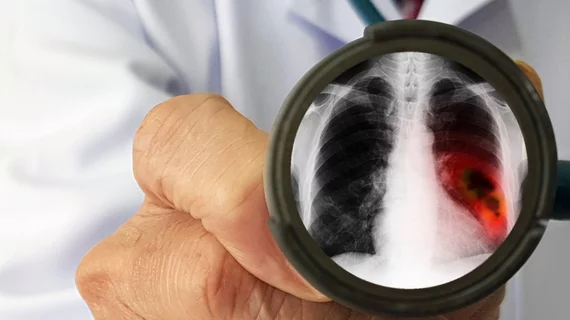AI shows potential to reduce radiologists’ chest X-ray workload in an outpatient setting
Artificial intelligence is demonstrating promise in its ability to reduce radiologists’ chest X-ray workload in an outpatient setting, according to a new large-scale study published July 12.
Scientists with Siemens Healthineers retrospectively tested the algorithm on radiographs from over 14,000 patients. Individuals were imaged at Zwanger-Pesiri Radiology LLP, an outpatient imaging center with multiple locations in the northeast U.S., between 2020 and 2022, according to research published in Academic Radiology [1].
The percentage of scans with no actionable findings was about 71%. And the “AI NAD Analyzer” correctly classified such “unremarkable” cases with a sensitivity of 29% and a yield of nearly 21%. Specificity (how well it can distinguish images with disease from those without) was nearly 99%, with a miss rate of just 0.3% of cases.
Significant findings were missed just 0.06% of the time, with AI overlooking zero instances that included critical findings, lead author Awais Mansoor and colleagues reported.
“In an outpatient population, AI can identify 20% of chest radiographs as [containing no actionable disease] with a very low rate of missed findings. These cases could potentially be read using a streamlined protocol, thus improving efficiency and consequently reducing daily workload for radiologists,” Mansoor, an AI researcher with Siemens, and co-authors concluded.
All patient cases had both posterior-anterior and lateral chest radiographs. There was a large spectrum of indications, including frequent occurrence of cough, shortness of breast and chest pain, with about 29% containing actionable disease. The AI Analyzer correctly identified 2,891 scans as having no actionable disease, or 21% of all cases in the outpatient population.
Mansoor and co-authors see particular benefit in “situations with high case volumes, which often lead to long work lists and reading delays.” However, while autonomous interpretation of unremarkable chest radiographs may be possible in the future, the NAD definition in this study is made “with the intention that all cases are ultimately reviewed by a radiologist.” Results from the algorithm may be used to help prioritize work lists so that urgent cases can be read first, and there may be shorter reading workflows for nonremarkable cases, “enabling efficiency gains,” the authors noted. Future iterations could combine the AI NAD Analyzer with other AI systems that detect specific abnormalities for a more comprehensive decision support system.
“Workflow integration will be key for adoption in clinical practice. Incorrect results by AI may bias the radiologist towards expecting normal or unremarkable exams and radiologists need to be aware of this,” the authors wrote. “There may also be workflow options that can help to reduce or suppress the bias. Workflow impact needs to be tested (combined reading by AI and radiologist) to assess efficiency, accuracy, and reader confidence benefits. Ongoing quality control should be considered as part of a systems-based approach. The objective of this study was to demonstrate AI’s immense potential in identifying unremarkable cases so that resources can be focused over time to cases with significant findings. The percentage of NAD cases correctly detected by the system will increase as future iterations of the system learn to distinguish non-actionable from actionable findings.”
Read more at the link below.

